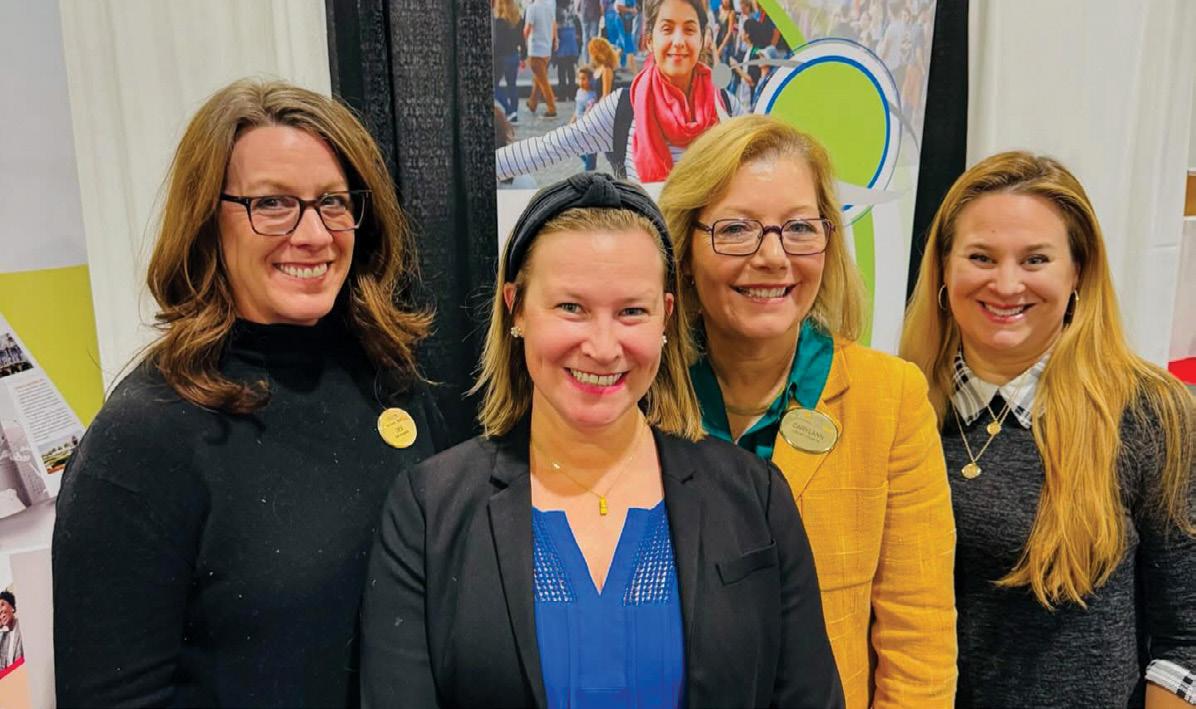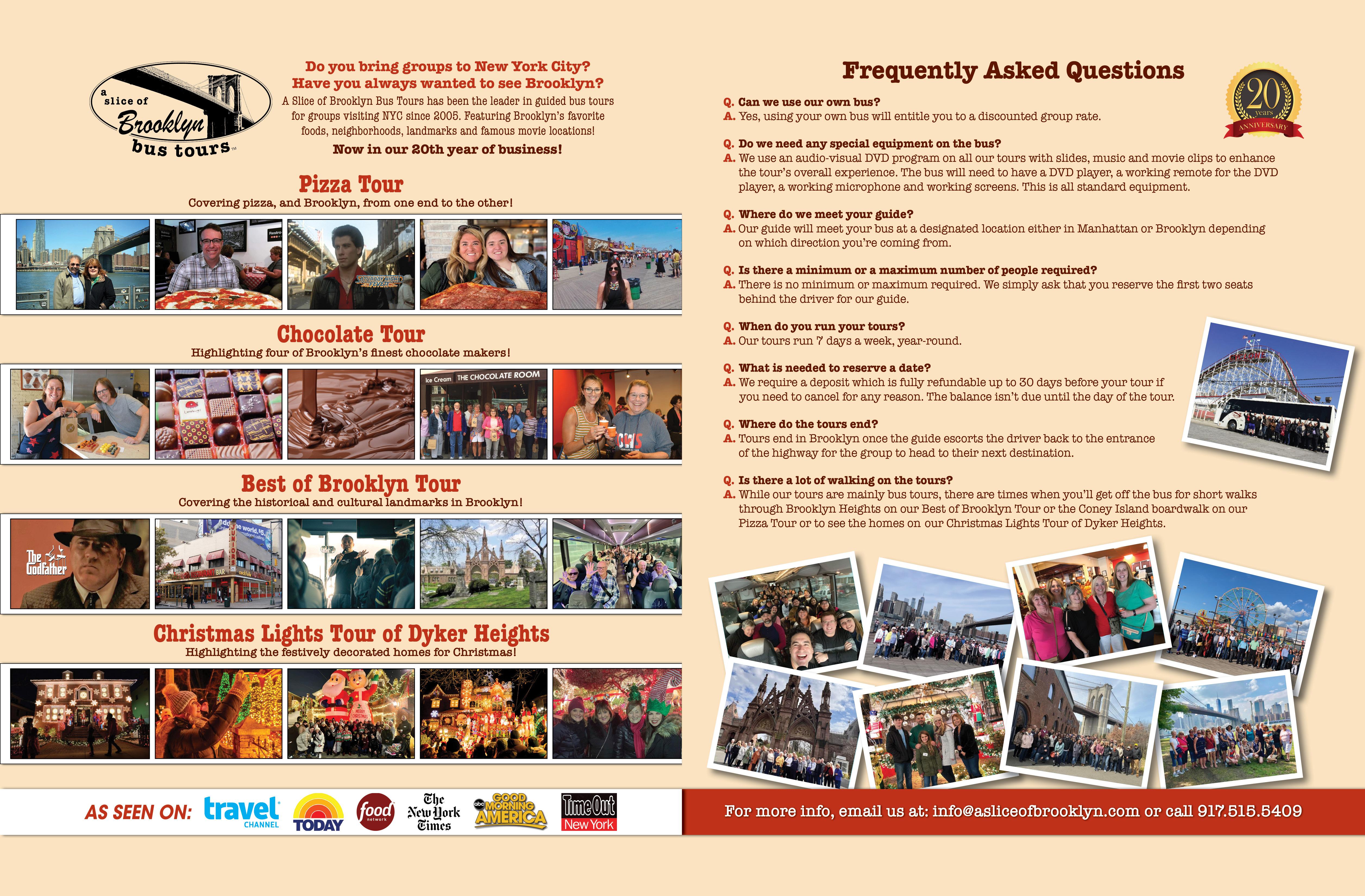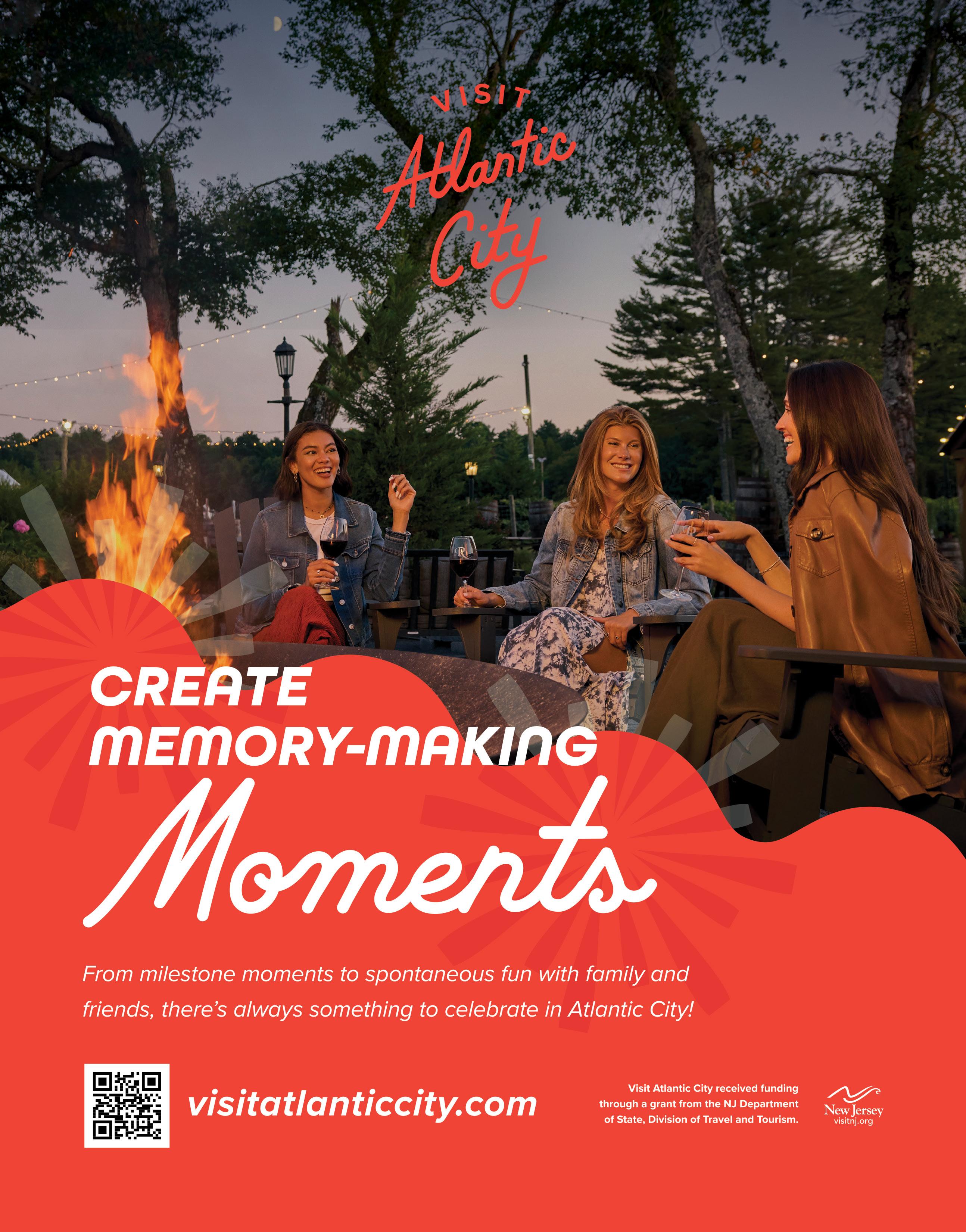THE RESOURCE FOR EVERYTHING GROUP TRAVEL.


THE RESOURCE FOR EVERYTHING GROUP TRAVEL.

THE CRITICAL IMPORTANCE AND POWER OF DEI IN TRAVEL LET LOOSE IN THE LONE STAR STATE! CUSTOMER SERVICE ETIQUETTE: BACK TO THE BASICS
FIVE MINUTES WITH... COURTENAY BETTS

JULY/AUGUST 2025
Volume 23, Issue 4

GROUPS TODAY IS PUBLISHED BY: Serendipity Media, LLC 866-252-7108 www.serendipity-media.com
PRESIDENT & PUBLISHER
Kasie Smith
ART DIRECTOR
Courtney Van Hagen
MANAGING EDITOR
Sarah Suydam
GRAPHIC DESIGNER
Claire Chapin
ACCOUNTING & OPERATIONS SPECIALIST
Megan Marshall
MARKETING COORDINATOR
Hannah Hohman
COMMUNICATIONS & EVENT COORDINATOR
Maggie Mutch
MEDIA CONSULTANT
Haleigh Gerwig
haleigh@serendipity-media.com
MEMBERS OF:
Student & Youth Travel Association American Bus Association National Tour Association Circle Michigan Ontario Motor Coach Association
Groups Today is published bimonthly by Serendipity Media, LLC; 535 Cascade West Parkway SE; Grand Rapids, MI 49546. Periodical postage is paid at Grand Rapids, MI, and additional mailing offices.
Subscription information may be obtained through the above address, by calling 866252-7108, or by visiting www.serendipitymedia.com or www.groupstoday.com.
POSTMASTER: Send address changes to Groups Today c/o Serendipity Media, LLC; 535 Cascade West Parkway SE; Grand Rapids, MI 49546.
All rights reserved. Groups Today content may not be photocopied or reproduced or redistributed without the consent of the publisher.
© 2025 Serendipity Media LLC
JJ Bell & Cindy Steffensmeier: Teaming Up to Create Experiences That Excite page 4
5 MINUTES WITH... Courtenay Betts, Director of Operations - North America, EF Explore America | President, SYTA page 26

page 10
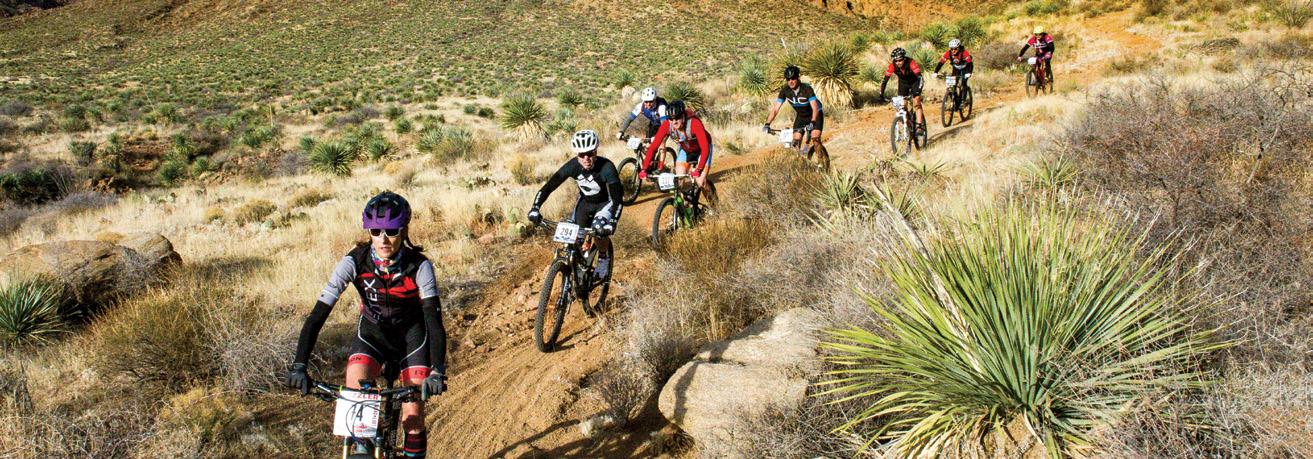
page 20

The Critical Importance and Power of DEI in Travel page 6

EDUCATION
Customer Service Etiquette: Back to the Basics page 25
It’s the time of year we all dream about—when sunshine abounds and adventures are aplenty. Like us here at Groups Today , we hope you’re also getting out and enjoying the sights, scents and sounds of summer in all the ways you’ve pined for all winter long.
In this new issue of Groups Today, we’re celebrating the power of travel, whether it’s focusing on the social impact and benefits of student travel (page 10) or how the power of diversity, equity, and inclusion makes the industry stronger (page 6), we’re thrilled be sharing this truly valuable and timely insight.
We also take the time to touch base with Courtenay Betts, Director of Operations - North America, EF Explore America, to get her take on industry changes, reflections on her time as SYTA President, and what opportunities she sees for making student travel more inclusive and accessible. Also featured are JJ Bell & Cindy Steffensmeier, the team behind the successful Nebraska-based Excite Experiences (page 4). From homemade cookies to lessons in perseverance, their story is one to remember.
If you’re thinking of letting loose for your next trip, consider all that awaits in the Lone Star State! Flip to page 20 to read about all things Texas. We have the inside scoop on the top places to go—and attractions to see. We’re also offering up some practical knowledge and reminders about customer service etiquette—a topic always deserving of our focus (page 25).
Wherever your summer takes you this year, we wish you and your groups safe travels!

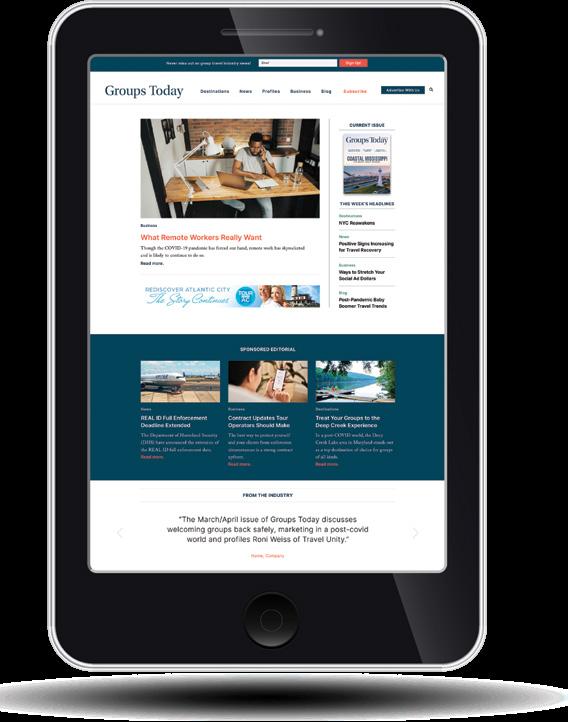

SARAH SUYDAM Managing Editor sarah@serendipity-media.com
Send your stories, suggestions and thoughts to:
535 Cascade West Parkway SE Grand Rapids, MI 49546
sarah@serendipity-media.com








By Sarah Suydam

TTravel has always been part of JJ Bell’s life. As grandson of wellknown industry leader Moostash Joe, he’s never second guessed the value of a good trip, whether it was helping plan the family’s trip to Disney in 1999 or their adventures to places like the Black Hills, Colorado and Minnesota.
He cites his first trip to Europe as a pivotal moment.
“I remember flying into Paris, riding the subway into the city, and
coming out right next to the Paris Opera House … it was everything you think Paris is, and a feeling I’ll never forget,” said JJ, who went on to work as a tour guide and director during his time at Midland University. “I fell in love with giving people the same feeling I got in Paris.”
Alternatively, Cindy Steffensmeier (JJ’s aunt), got her entrepreneurial start in the restaurant business with her husband before shifting
to a career in finance, and later, to tour and travel management. Cindy has always enjoyed dreaming up experiences and developing great relationships with her customers.
“One day my dad—who’s had a travel agency for 50 years—calls me and says, ‘I want you to come work for me. I’ll give you a week to decide.’ So, naturally, I went,” Cindy recalled. “And six years later, JJ joined in, too.”
Soon, the aunt and nephew pair
were inspired to start their own travel business.
Together, with a dream and $100, JJ and Cindy put their prior experience, skills and passion for travel together to found Nebraskabased Excite Experiences from the ground up in 2012. They’ve since built a number of itineraries that feel like the perfect blend of a tour and a vacation, despite a slow start and roadblocks from the COVID-19 pandemic—a time which actually allowed Cindy and JJ to retool some processes and demonstrate their commitment to their clients. They’ve since said “good-bye” to the days of van-sized tour groups and “hello” to consistent bus-sized groups.
From Mackinac Island to Santorini to their blockbuster “All the Small States” tour of New England, Excite now has close to 100 public and private tours a year, with their sights set on continuing to scale and grow their offerings.
The genuine care and focus on the little things by JJ, Cindy and their team is truly what elevates Excite’s travel experience for their groups. From the cookies (homemade by JJ’s mom) which guests are given upon arrival to purposefully simple deposit policies, these are the details Cindy and JJ are proud to intentionally focus on.
“Our dream is making other people’s travel dreams come true— and it’s very cool to be putting that out into the universe,” JJ said. “People are out there who want to travel … or perhaps they want to start a tour company … or just be in the travel industry in general! Either way, it can be magical. They should jump in.”

JJ enjoys cooking and approaches the hobby much like building a tour—putting all the different pieces together bit by bit to make something incredible.

A quiet force, Cindy might not be the loudest voice in the room, but when push comes to shove, she’ll say her piece—and probably make you laugh while doing so.
By Sarah Suydam

WWhile some corporations, educational institutions, and organizations are rolling back their diversity, equity and inclusion initiatives, many are standing firm in their commitments, understanding the power and necessity of DEI. We tapped the expertise of industry leaders to learn why centering these principles make the industry a stronger and more inclusive place for travelers of all kinds.
According to Roni Weiss, Executive Director, Travel Unity, people often put DEI into a small box.
“Yes, race and ethnicity are important parts of identity that we need to consider, but if we’re talking
about staff, customer, or community experiences, we need to consider all of the different aspects of what makes a person who they are,” Weiss said. “This includes disability status, gender identity, and dietary restrictions. Yes, gluten free and not drinking alcohol should both be considered part of DEI.”
Stephanie M. Jones, CEO and Managing Director, Disrupt for Change, shares that although many have excluded DEI as a priority or refer to it by another name, we should be less focused on the terminology and more focused on outcomes which address racial inequality, economic injustice, lack of cultural
representation, and industry access.
“As a Black woman who has built her career advocating for underrepresented Black tourism businesses, DEI should mean ensuring that Black tour operators, cultural institutions, and tourism entrepreneurs have an economic stake in the market,” Jones explained. “It’s about making sure our stories, our communities, and our businesses are not only seen, but supported, funded, and elevated across the global travel & tourism ecosystem.”
John Tanzella, President and CEO, International LGBTQ+ Travel Association (IGLTA), notes that the
world watches how our industry shows up—especially in times of social and political uncertainty.
“Inclusive practices aren’t just a moral imperative—they’re a business advantage,” Tanzella stressed. “LGBTQ+ travelers, for example, are a highspending segment that actively seeks out destinations and brands aligned with their values. It’s through these practices that the entire industry becomes more resilient, more innovative, and more globally connected.”
Weiss notes some actionable steps industry professionals can take to prioritize these principles.
“Having a sincere public-facing DEI statement (and you don’t have to use the term ‘DEI’ to show you’re inclusive) and an internal structure (whether a certain role is assigned to this or a regularly meeting committee) to continue this work are both vital,” he said, also sharing that Travel Unity’s publicly available standards provide road maps for both organizations and special events and sports.
If you don’t know where to start, Tanzella recommends listening to voices within the communities you’re trying to serve and partnering with organizations that are already doing the work.
“Invest in training, inclusive marketing, and policy review,” Tanzella suggested. “Don’t just celebrate diversity when it’s
Resources to Consider:
convenient; demonstrate consistency year-round. And most importantly, be transparent and accountable. Inclusion is not a checkbox—it’s a commitment that should shape your decisions every step of the way.”
The risks for not prioritizing DEI in travel, according to Jones, are both immediate and long-term.
“Travel brands and DMOs risk alienating diverse consumers—especially Gen Z and Millennials—who expect brands and destinations to align with their values,” she said. “But perhaps even more damaging is the missed economic opportunity. Without an intentional focus on DEI, the industry leaves billions on the table by failing to invest in diverse suppliers, tourism tech innovators, and markets.”
Jones encourages industry leaders to move beyond performative allyship and co-create solutions with those who’ve been on the frontlines of this work for years.
“True commitment is shown in how you spend your budget, who you partner with, and whether your values show up in your business decisions,” she said. “When DEI is rooted in action, not just rhetoric, the entirety of the travel & tourism industry can become more sustainable, equitable, and profitable. DEI should make space for a broader range of narratives, businesses, and experiences that reflect the true richness of the world we live in.”
» Join the Travel Unity Alliance, which also offers individual and organizational certifications appropriate for all professionals: travelunity.org.
» Learn how Disrupt for Change is addressing racial inequity in travel & tourism: disruptforchange.com .
» IGLTA Foundation’s Comprehensive Guide for LGBTQ+ Inclusive Communication in Tourism to help communicate more thoughtfully and respectfully with LGBTQ+ travelers: iglta.org
FEATURED IN THIS ARTICLE:

RONI WEISS
Executive Director, Travel Unity
Headshot © Travel Unity
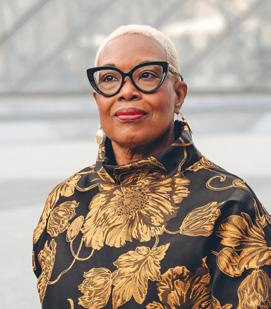
CEO & Managing Director, Disrupt for Change
Headshot © Osh Photography

TANZELLA President & CEO, International LGBTQ+ Travel Association
Headshot © IGLTA


By Sarah Suydam

While there are plenty of niche areas for tour operators and travel advisors to focus on, some would say none are quite as vastly impactful and influential as student travel. A continuously growing sector, student travel has been proven to have incredibly beneficial social impacts on those students lucky enough to experience it. Keep reading to learn more about why student travel could not only bolster your business, but fill your feel-good bucket, as well.
The 2024 SYTA Student Travel Business Barometer offers up much-needed historical data on the growth of the student travel sector. Findings indicate that not only is this niche currently flourishing, but it’s expected to continue to do so well into the future. Some highlighted findings from the most recent Barometer include:
Student travel represents 27% of global tourism
The estimated value of the student travel industry is $185 billion.
More than 26,700 student trips have taken place with SYTA members.
More than 3 million students have traveled with or used SYTA members.
Students who travel with their classmates around the world are not only treated to incredible experiences which allow them to create lifelong memories, but they also become exposed to a number of social benefits that can have profound effects on the rest of their lives. Whether a trip is focused on educational value, performance opportunities or is simply just for fun, there’s something to be gained.
According to post-travel findings from the SYTA Student & Youth Travel Digest , students reported …
An increased willingness to know, learn and explore.
A desire to travel more in the future.
An increase of independence, self-esteem and confidence.
More intellectual curiosity.
An increased acceptance of other cultures and ethnicities.
Better adaptability and sensitivity.
Increased tolerance and respectfulness.
Better cooperation and collaboration.
Better self-expression.
An increased desire to be more outgoing.
In a time when cultural understanding, an expanded worldview and human connection is more important than ever, travel can hold the key for students broadening their perspectives on not only what learning can look like, but also humanity as a whole.

Encourage educators and group leaders to get the ball rolling as early as possible on trip planning. Work with the educator ahead of time to determine what the purpose of their trip is (educational, performance, etc.) and what they’d like the takeaways to be. Traveling in the “off season” could also mean smaller crowds, better availability at top attractions, lower ticket pricing, more customized experiences, etc. With cost being one of the most common barriers preventing students from being able to experience travel, planning early also allows more time for securing scholarships and for fundraising opportunities to take place.
In addition to securing trip approval from the school board, educators are tasked with helping parents feel at ease about sending their child off in their care to a sometimes far away destination. Encourage educators to bring parents into the fold by including them in the process of planning from the very beginning—host meetings to share information and ask questions; over communicate; propose and discuss fundraising ideas; have a student or parent who has traveled on a similar trip in the past share their experience; address safety concerns and cell phone policies, etc.
It’s also worth noting how challenging sourcing chaperones can be. Assist educators by working with them or the group leader to create materials outlining expectations from both parents and students.
Continued on page 14...
Interested in learning more about what destinations are on the rise for student travel? See which locations—both in the U.S. and abroad—made the cut by checking out SYTA’s 2025 Top Student Travel Destinations: teachtravel.org/tools-and-resources



Looking to fully dive in on student travel? Consider attending the 2025 SYTA Annual Conference in Savannah, Georgia from August 22-26, 2025 . This is the only annual conference in North America where anyone who is passionate about promoting, selling, and providing travel experiences for students will find dedicated, insightful and actionable collaboration that will advance their student and youth travel business.

DEMONSTRATE YOUR COMMITMENT TO EXCELLENCE.
SYTA, in partnership with Center for Student Travel Safety (CSTS), offers individuals and organizations the opportunity to voluntarily demonstrate their commitment to overall safety and risk management practices as it relates to student and youth travel, thanks to the Certified Student Travel Organization (CSTO) and Certified Student Travel Professional (CSTP) certifications. Those individuals and/or organizations who complete these certifications have met or exceeded the minimum of 25 safety standards established by SYTA and CSTS, and thereby exhibit their credibility to travelers. If you’re looking for a way to build confidence with student groups and prove to educators that you’re the right fit for their trips, CSTO and CSTP certifications are wise.









Looking for a fun and memorable way to see the natural beauty of Jefferson Parish, Louisiana? Swamp tours—offering both unforgettable views and historic insight—are just the thing to get groups’ hearts racing.
On a swamp tour in Jefferson Parish, groups will find themselves immersed in lush vegetation while respectfully traversing a fragile ecosystem, admiring various wildlife, and enjoying the thrilling opportunity of being up close and personal with an alligator! As groups glide through beautiful moss-covered cypress trees, knowledgeable boat captains share interesting facts about the hidden wetlands and their deep history.
And did you know? There are plenty of options for making your group’s swamp experience exactly what they’re hoping for. Choose from traveling at high speeds through the swamps on an airboat tour. Or, take a more leisurely tour on a boat.
Groups can even rent kayaks and see the swamps at their own pace!
One incredible option to consider is a Total Cajun Experience at Jean Lafitte Harbor! Groups will tour the bayous of Lafitte and experience an educational, interactive, hands-on approach to what it’s like to be a Cajun. They’ll pull up a crab trap, bait and set trout lines, set a jug line—and possibly spy a gator. After groups see how this amazing seafood is caught, they’ll go back to the pavilion where one of the company’s in-house chefs will present and prepare the food they just caught in the bayous!
No matter how you slice it, if you’re visiting Jefferson Parish, a swamp tour is a must for your group’s itinerary.
Frederik Meijer Gardens & Sculpture Park in Grand Rapids, Michigan—named Best Sculpture Park in the United States in 2023, 2024 and 2025 by USA TODAY 10 Best Readers’ Choice Awards—has acquired a monumental sculpture for its permanent collection: Amalgam (Origin) by internationally celebrated artist Nick Cave. This work expands and diversifies Meijer Gardens’ permanent collection of more than 300 international sculptures, also distinguishing it as the home of the artist’s first ever public outdoor sculpture.
“With its epic scale and artistic import, this acquisition underscores our ongoing commitment to sculpture that is at once transporting and challenging,” said Suzanne Ramljak, Vice President of Collections & Curatorial Affairs.
“The art of Nick Cave is new to Meijer Gardens’ collection and we are delighted that this exceptional artist will be represented by such a supremely powerful work.”
Amalgam (Origin) is an evolution, on a colossal scale of 26 feet tall, of Nick Cave’s iconic Soundsuits spectacular forms blending fashion and sculpture that were created in response to the brutal beating of Rodney King by police in 1991. Though they originated as a form of protection,
the Soundsuits have since developed into vehicles for empowerment, with Cave having made hundreds in varying shapes and materials, all based on the scale of his own body. Serving as a physical camouflage, the elaborate sculpted surfaces create a second skin that conceals race, gender and class, forcing viewers to look without judgement.
Cave’s work draws from craft traditions, fashion, vintage textiles and other labor-intensive practices to create surfaces that are visually ornate and historically specific. In Amalgam (Origin) , the collage-like element of his aesthetic is expressed by the highly textures and detailed bronze casting. In contrast to Cave’s earlier seated bronze, A•mal•gam , the monumental and towering Amalgam (Origin) appears firmly rooted in the earth, as if growing directly out of the soil. Like a community beacon, the sculpture celebrates each person’s unique individuality while connecting it to humanity’s shared grounding in the natural world.

Cranbrook Academy of Art, I also love the full-circle moment of my first major outdoor sculpture being in Michigan. I hope to see real birds nesting in the bronze branches when we visit next spring.”
Amalgam (Origin) will be installed by October alongside the North Path near The Richard & Helen DeVos Japanese Garden and Michigan’s Farm Garden. It arrives from a recent exhibition with two of his other new works at Jack Shainman Gallery in Tribeca in New York City, where it was exhibited as part of a series of three large bronze sculptures titled Amalgams .
“As we celebrate the 30th year of our beloved organization, we remain dedicated to growing and diversifying our world-class sculpture collection in meaningful ways,” said Charles Burke, President & CEO. “This acquisition marks an exciting milestone as we continue to expand our collection for future generations to experience and enjoy.”
“I am thrilled that Amalgam (Origin) will be finding a permanent home at Frederik Meijer Gardens & Sculpture Park,” stated Nick Cave. “It was developed specifically to be placed outdoors, and I can’t imagine a better home than at Meijer Gardens. Having done my graduate studies at Visit MeijerGardens.org/sculpture to learn more.
Where history, culture and innovation align.
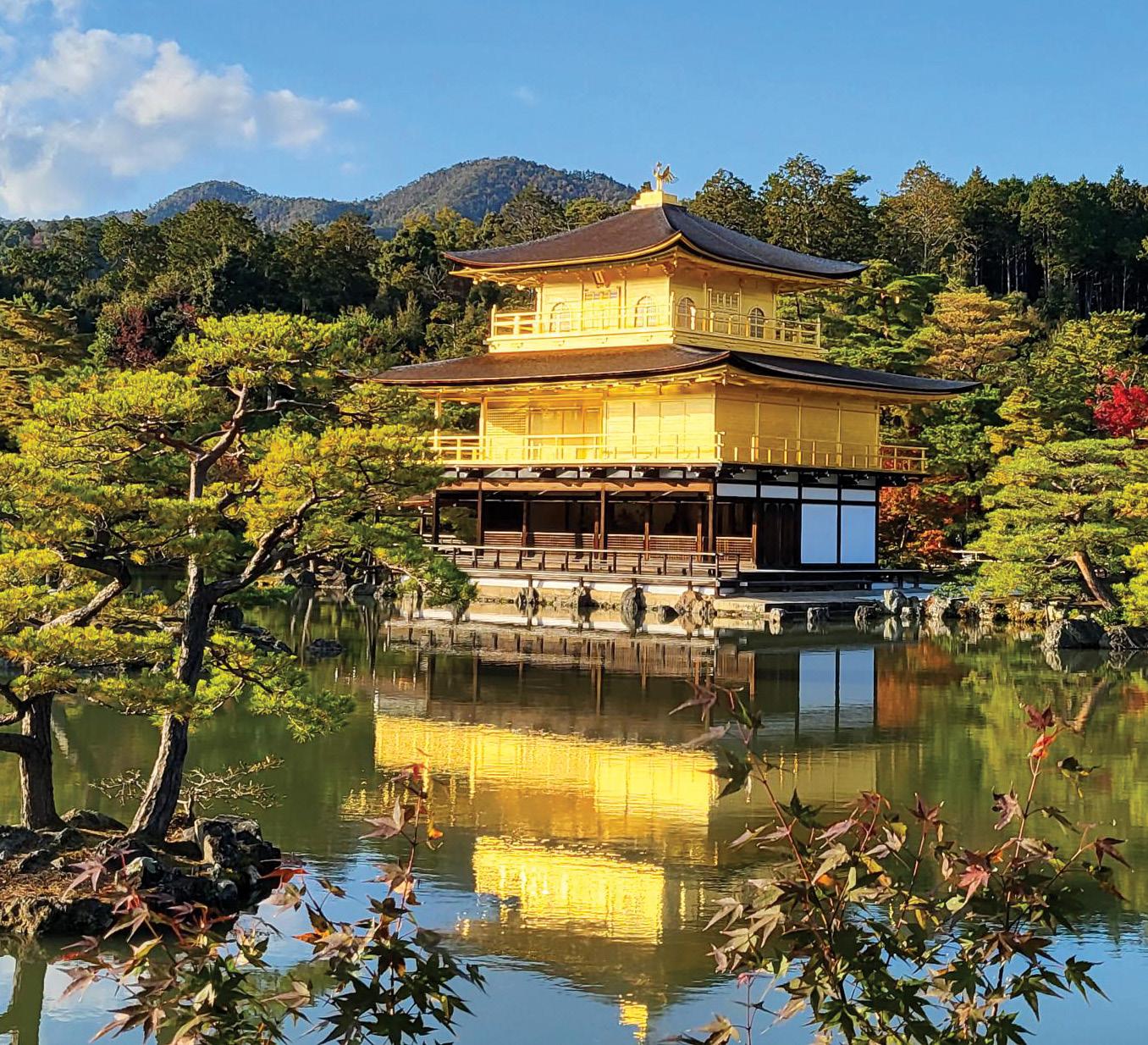
Kanazawa is a historic castle town with over 400 years of rich history. This town is bursting at the seams with tradition, from the Higashi tea district to the one-mile Samurai district.
Kanazawa is also the home of gold-leaf decoration, practiced here since the 16th century, making Kanazawa the epicenter of arts and crafts culture in Japan, with many other artistic practices emerging from these historic streets. Stunning gardens, fish markets, and Geisha quarters make Kanazawa a must-visit destination for any traveler looking to dig deep into Japan’s storied past.
KYOTO: BRIDGING THE GAP BETWEEN PAST AND PRESENT
There’s no place that exemplifies Japan’s rich culture like Kyoto. This city highlights how Japan’s history and culture go hand-in-hand, with its 2,000 temples and shrines co-existing with a modern cityscape.
Food is one of the most prominent ways to experience the overlap in tradition and innovation in Japan. In Kyoto, travelers can enjoy kaiseki ryori , a multicourse traditional dinner that emphasizes hospitality and artistry, and visit the new ramen spots in Fushimi to see what experimental chefs are adding to their bowls.
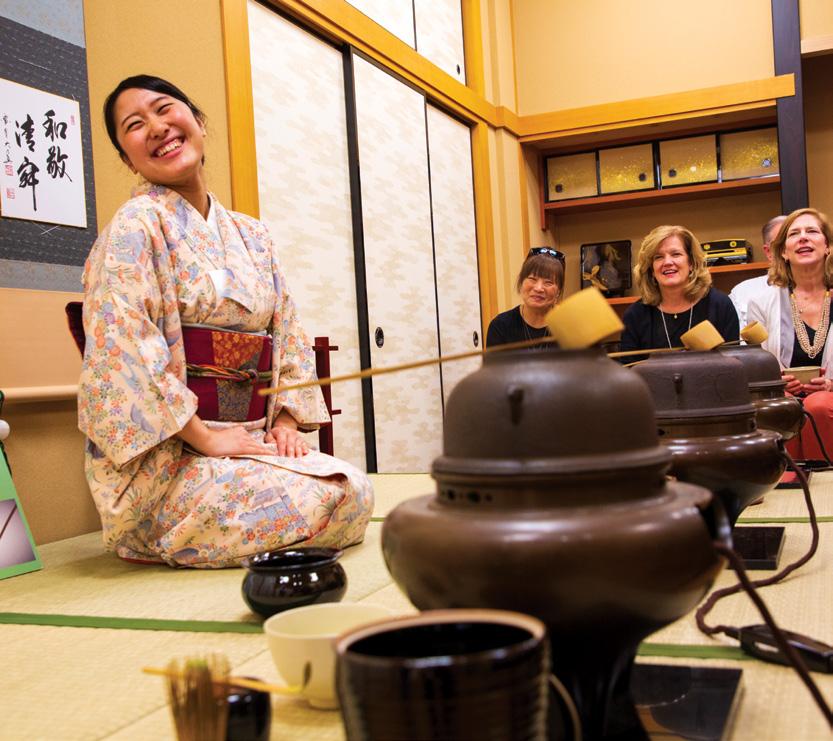

This electrifying city is unlike any other. The neon lights color the skyline and pop culture is turned up all the way. Travelers visit Tokyo from all over the world for world-class restaurants, bustling shopping streets, and dazzling live entertainment.
Visiting the atmospheric Yurakucho is a must for any traveler. Eateries and watering holes line the street under the elevated train tracks, and people can find cuisine of all kinds to satisfy their cravings, from traditional Japanese food to elegant French cafés and German beer halls.
Have you ever wanted to take part in an authentic sushi making class? Or try your hand at the centuries-old art of the Japanese tea ceremony? Collette’s Cultural Treasures of Japan tour takes groups to the must-visit destinations in Japan, including Kanazawa, Kyoto, and Tokyo, as well as destinations for cultural connections like the Owakudani volcanic zone, the Zen temple of Kinkakuji, and Hiroshima, where groups will visit the Hiroshima Peace Memorial. Plus, travel by the famous shinkansen bullet train for panoramic views of the Japanese countryside.
Booking Collette is risk-free for groups, with no minimum group size or deposit required to save space on tour. Plus, Collette provides group leaders with a local Business Development Manager and free promotional materials to help grow your group’s travel program.
OF JAPAN
14 DAYS
• Tokyo
• Asakusa Sensoji Shrine
• Ginza
• Tea Ceremony
• Hakone
• Lake Ashi Cruise
• Matsumoto Castle
• Takayama

Learn more about Cultural Treasures of Japan:



By Allison Kay Bannister
TThinking of taking your group deep in the heart of Texas? Given it’s the second largest U.S. state in both population and area, you’ll have a lot of ground to cover! Good thing we have the inside scoop for you on the top places to go—and attractions to see. Let’s jump in!
El Paso has a number of draws, whether it’s enjoying wine, food, music, and picturesque views at nearby wineries or getting your thrills with a guided UTV tour through scenic Red Sands. Franklin Mountains State Park is another favorite, with 100-plus trails to hike, including El Paso Tin Mine Trail or a trek to Aztec Caves. There are opportunities for biking and rock climbing, too.
Hueco Tanks State Park & Historic Site is also great for hiking and rock climbing, as well as bird watching. And, before leaving Sun City (it does boast about 300 days of sunshine yearly!), be sure to check out El Paso Mission Trail, recently ranked by the Texas Travel Awards as the best historic site in Texas. In addition to Ysleta Mission, Socorro Mission, and the Presidio Chapel of San Elizario, there are several restaurants, art galleries and shops along the trail.


Situated perfectly amid greater Dallas-Fort Worth (DFW) is Mansfield . It’s more than just a jumping off point for its neighbors, though! Groups will want to take a free tour of the Man House Museum—a renovated home of one of the city’s founders that provides a view into life in 1890s Texas. And, see a show at historic Farr Best Theater or soak up the great outdoors at Oliver Nature Park—an 80-acre nature preserve.
For dining and refreshments, our friends at Mansfield CVB recommend The Backyard, an interconnected series of restaurants located downtown. Whether it’s barbeque, burgers, Tex-Mex, or a juicy steak, this spot has something for everyone! There’s also Our Place for classic Texas fare and Dirty Job Brewing, which has ample seating and live music regularly.
Dallas is just a short drive from Mansfield, and there’s plenty to do and see there. For the arts and culture crowd, top picks include Dallas Arboretum and Botanical Garden, Dallas Museum of Art, and Nasher Sculpture Center. For those more interested in recreation, check out Sandy Pickle, an all-in-one spot for pickleball, sand volleyball and golf simulation; Good Surf for pickleball and yard games, plus a surfing machine; Bowlounge for classic bowling; and Electric Shuffle, which offers high-tech shuffleboard. All four have food and drinks, too.
Other fun things to do include taking a guided pub crawl with Dallas Party Bike, watching live programming on Cosm Dallas’ immersive dome screen, or getting creative at Tiles Workshop. Strolling Dallas Farmers Market and grabbing a bevvie at Katy Trail Ice House are also popular options.

They don’t call DFW a Metroplex for nothing! Another big part of this 11-county, North Texas area is Fort Worth . Whether you see a cattle drive at the Stockyards or tour Billy Bob’s Texas, the world’s largest honky tonk, your group will have an authentic Texas experience. Add to the charm by getting fitted for custom boots at Leddy’s and a custom hat at Flea Style or Best Hat Store.
Foodies can tour the Near Southside and art lovers can spend a day in the Cultural District. And, Bass Performance Hall, Jubilee Theatre and Circle Theatre all offer live theater shows. Definitely take time to shop the boutiques along Magnolia Ave and South Main Street, and have a meal at Lonesome Dove, Provender Hall or Panther City BBQ. Also in the DFW region is Grapevine . Groups are invited to take a ride on the Grapevine Vintage Railroad and explore historic Main Street, home to several late-1800/early-1900 buildings repurposed into galleries, boutiques, cafés and winery tasting rooms. A visit to Nash Farm to learn about 19th-century farm life is in order, as well.
Grapevine Mills is, in itself, a destination to discover. In addition to being a bustling shopping center, it is home to the Meow Wolf Grapevine immersive art installation experience and SEA LIFE Grapevine Aquarium. And, don’t leave the city without seeing a classic movie or a live tribute performance at the 1920s-era, arch-ceiling Palace Theatre on Main Street.
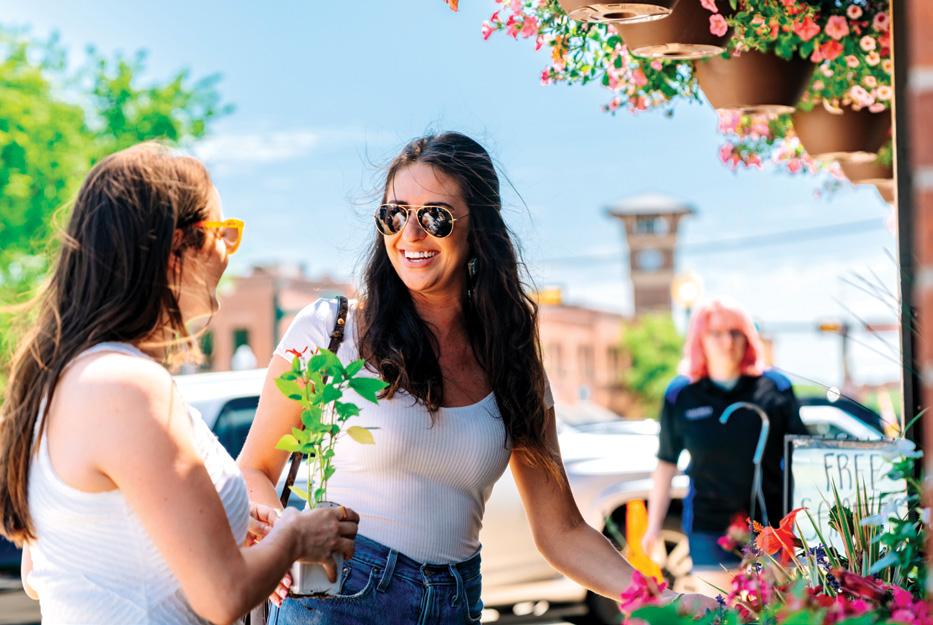

San Antonio is a cultural hub with beloved attractions that include the San Antonio Botanical Garden, Witte Museum, San Antonio Museum of Art, Japanese Tea Gardens and McNay Art Museum. It’s also known for its 15-mile River Walk, considered a must-do while in the city. The largest urban ecosystem in the country, the River Walk has numerous distinct points of interest along the way.
Another group-friendly activity is a river cruise or charter with Go Rio River Cruises. There are a number of themed cruises, many of which feature dining, entertainment and vibrant views of the River Walk from the water. Or, take a hands-on, chef-instructor led course in cooking, baking, wine and more at Culinary Institute of America San Antonio.
Next up, Amarillo —the largest city on Texas Route 66! There’s clearly an automobile theme going on here, with Bill’s Backyard Classics, a car museum with 90-plus vehicles on display; Cadillac Ranch, which has 10 brightly painted Cadillacs buried nose-down in a field; and, similarly, Slug Bug Ranch, with its graffiti-adorned Beetles, Global Art Wall, picnic area, gift shop and other amenities.
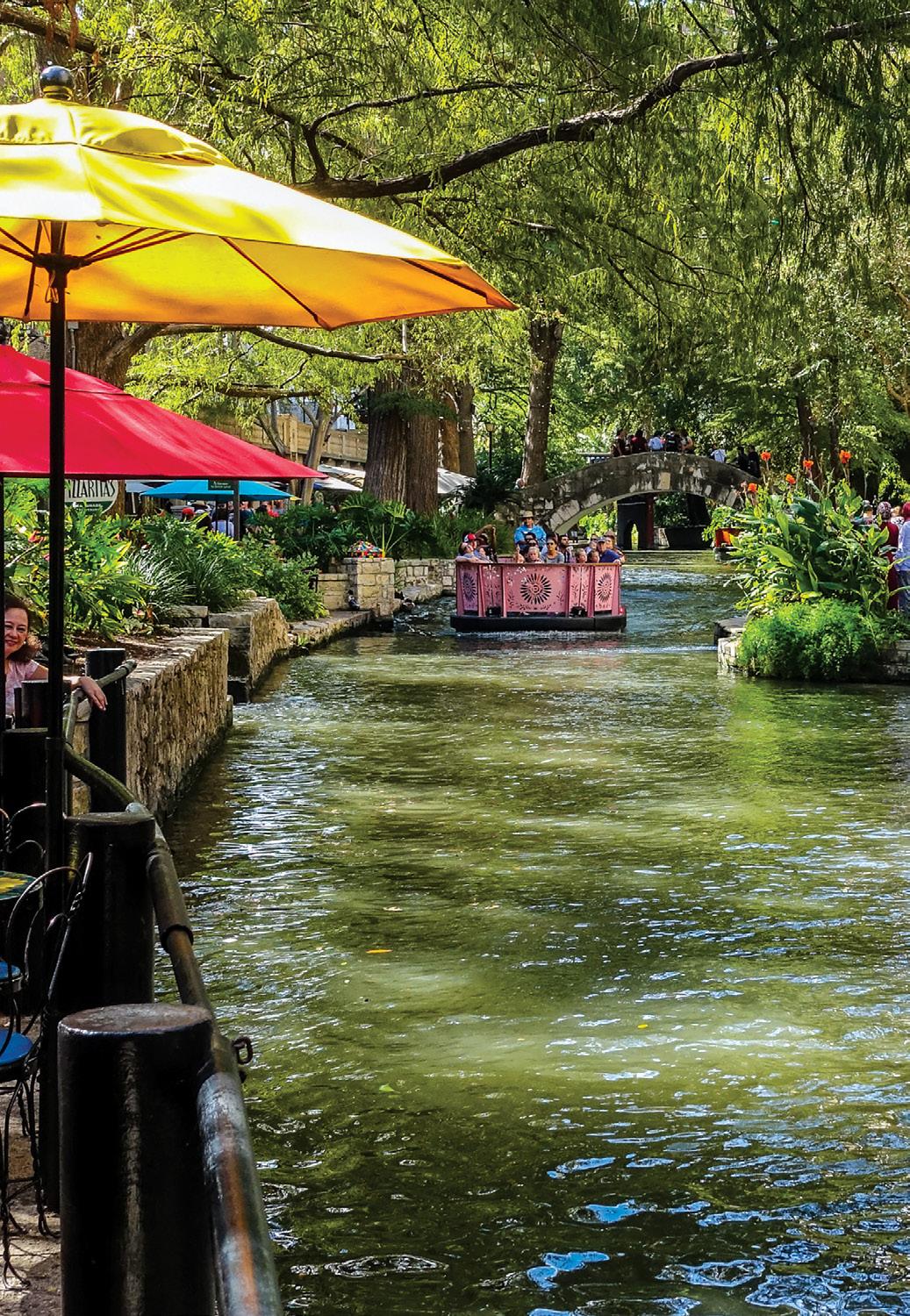


Group travel planners will also want to consider horseback riding and chuckwagon events with Cowgirls and Cowboys in the West, a Jeep tour at Palo Duro Creek Ranch, and a stop at Buc-ee’s—a Texas icon. After a full day, wind down at Old Tascosa Brewery or Paramount Recreation Club speakeasy. And, many visitors rave about seeing TEXAS Outdoor Musical held at nearby Palo Duro Canyon State Park, about a 30-minute drive from Amarillo.
Known as the Live Music Capital of the World®, Austin , of course, attracts visitors for its music scene. But there’s so much more to do, including a variety of historic and city tours, a sunset bat cruise (you read that right!), and tons of outdoor recreation, from hiking and cycling to kayaking and standup paddleboarding. Circuit of the Americas (COTA) racetrack and entertainment venue is also an area hot spot.
Dining is on the menu in Austin, too, with 44 of its restaurants recognized in the MICHELIN Guide Texas. And, of course, Austin is known for its festivals, such as SXSW in spring and Austin City Limits Music Festival in fall—to name just a couple.

By Sarah Suydam

In a lot of ways, the world around us continues to move at an incredible pace, often leaving our plates fuller than ever while being challenged to evolve and keep up—or else. Within the chaos and commotion of trying to stay on pace with what’s next, sometimes the fundamentals of doing something truly well can fall to the wayside. One area that still deserves your undivided attention and effort? Customer service.
Let’s revisit some points of customer service etiquette that are always worth the extra emphasis.
TIMELINESS IS TRULY TIMELESS.
Whether it’s responding to an email, meeting a deadline, or pulling together a quote, replying in a reasonable time window should always be a priority. Of course, life happens, and sometimes your original timeline isn’t always feasible. Should that be that case, communicate that! Even just extending a note of acknowledgement that you’re running behind goes a long way.
FOCUS ON WHAT’S POSSIBLE —NOT WHAT’S OUT OF REACH.
Your baseline should always be approaching a situation from the perspective of what’s possible vs. what’s not. If a client comes to you with a request that is outside of what you’ve done in the past, rather than poo-pooing the idea immediately, consider the possibilities! Can you make it happen? If not, can an alternative with a similar outcome be achieved? Remember to stay creative and flexible—it’s often in those realms that innovation blossoms.
YOUR COOL AND CHUG ALONG.
Much like life itself, stressful situations will often arise when working with colleagues, industry partners or clients.
Don’t let a moment of frustration or overwhelm manifest itself in your decision making or communication. Do your best to navigate things in the moment, and then reflect on what made the situation stressful in the first place. Is there a way to mitigate that level of intensity in the future?
LISTEN CAREFULLY AND ACTIVELY.
Not enough can be said for remembering the little details of a conversation. As you build your relationships with clients or colleagues, be present and truly listen to what’s being shared. Whether it’s a bucket list item they’ve got their heart set on for an upcoming itinerary or simply details about life and family, people feel valued when these finer details are acknowledged and rehashed.
AND SELF-AWARENESS ARE NEVER OUT OF STYLE.
Don’t come out of the gate too hot! If a previously discussed agreement or desired outcome gets lost in translation somewhere along the way, rather than spouting off what you really want to say (“Hey! That’s SO not at all what we talked about. What the heck?!”) , take a moment to breathe and think a bit deeper. Formulating a statement that might land a little softer—while still getting your point across and addressing the issue—is bound to be much more effective and well received.
Yes, there never seems to be enough time to do all the things we need (and want) to do. However, that doesn’t mean it’s appropriate to ghost anyone. Not only is it bad business, it’s also, simply put, rude. Having a sales discussion that doesn’t seem to be going anywhere? Be honest! Don’t have the bandwidth to participate or contribute your expertise to something extra? Be honest! People won’t forget those who wasted their time or strung them along.
Edited by Sarah Suydam
GGroups Today recently caught up with Courtenay Betts, Director of Operations - North America for EF Explore America, and outgoing SYTA President. Betts began her travel career while in university, working as a tour director for a Canadian company based in Toronto—an experience that sparked a deep passion for educational travel. She joined EF in 2011 and has since built a diverse career across both the company’s Canadian and U.S. offices. Throughout her extensive work, Betts’ focus has remained the same: delivering exceptional educational travel experiences for students.
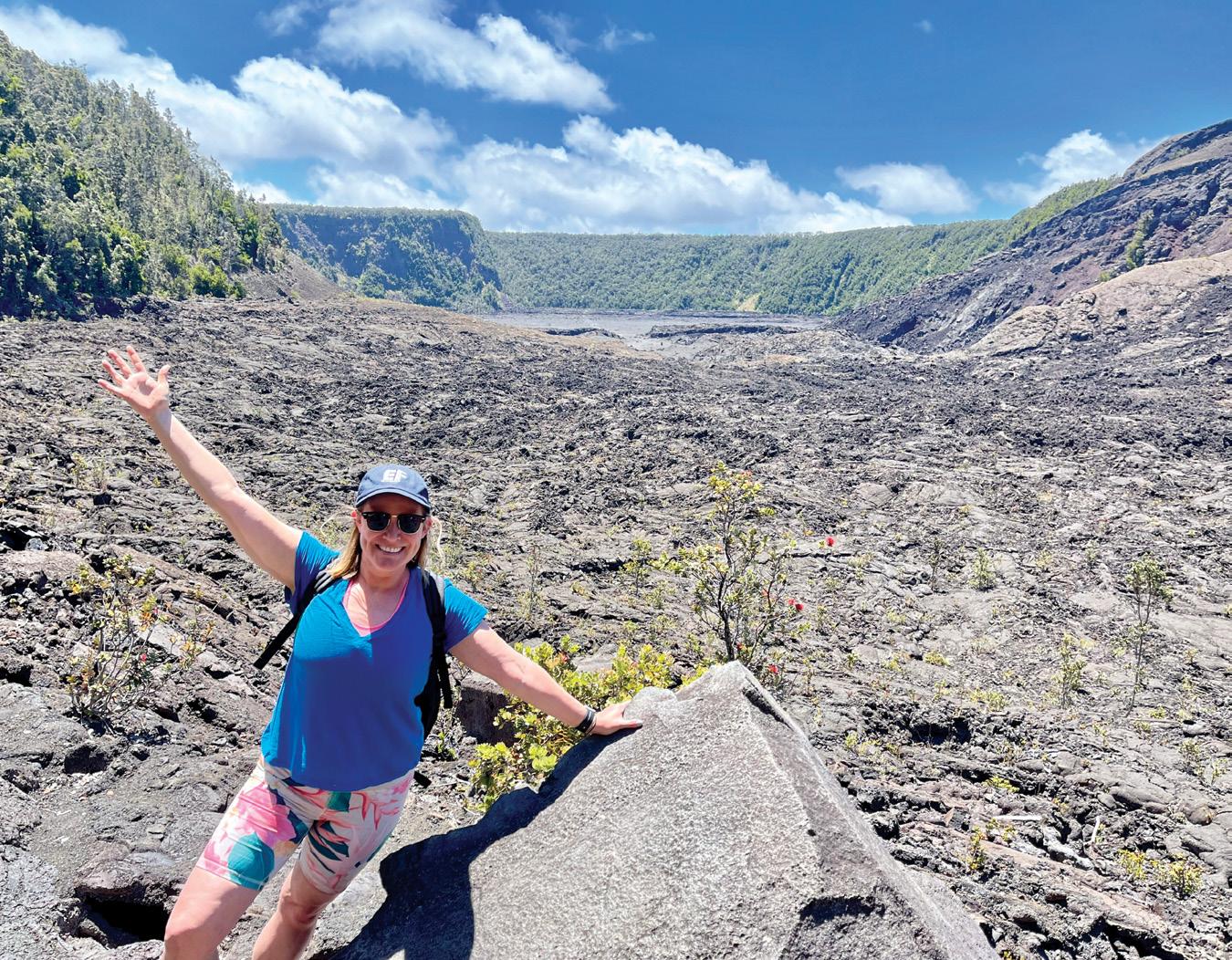

One of the most interesting changes has been the growing emphasis on the educational outcomes of travel. We’ve always known student travel was transformative, but there’s a growing focus on tying those experiences to learning objectives, socialemotional growth, and cultural competency. The rise of technology—both in how we operate and how students engage—has also shifted expectations and possibilities. Perhaps the most dynamic change has been the increasing need for resilience and adaptability. From geopolitical shifts to global pandemics, the travel industry has had to evolve faster than ever, and I’ve found the operational creativity that’s emerged from that to be really inspiring.
One challenge we face is how unpredictable the operating environment has become. From weather disruptions and safety considerations to supply chain issues and shifting regulations, change is constant—we need to be ready to adapt in real time. We’re also managing
labor shortages, rising costs, and evolving expectations around personalization, sustainability, and the overall experience. In student travel especially, there’s a growing need to reset expectations. The travel experience has changed—we need to be open to that evolution (how we plan, communicate, and deliver). It also means helping customers understand what today’s travel looks like, and why it’s still incredibly valuable.
There’s a huge opportunity to make student travel more inclusive and accessible—to help more young people see the world beyond their hometowns. We’re also in a moment where we can better communicate the value of travel as a learning tool, not just a trip. Today’s students are curious and socially aware—they’re craving opportunities to hear all sides of the story, to understand the cultures and communities that have shaped a destination, and to see themselves reflected in those stories.
That creates space for new programming that embraces diverse perspectives, for partnerships that connect travel with education in deeper ways, and for bringing more voices into the conversation—especially those that have been underrepresented. As SYTA President, I’ve seen firsthand how collaboration across our membership— operators, educators, attractions and destinations—can drive innovation in how we deliver these experiences and ensure they’re as meaningful, relevant, and inclusive as possible for the next generation of travelers.
You won’t find a more passionate, resilient group of people than those in the travel industry—but passion alone isn’t enough. You need to be operationally sharp, deeply empathetic and open to constant change. Most importantly—listen and ask questions.
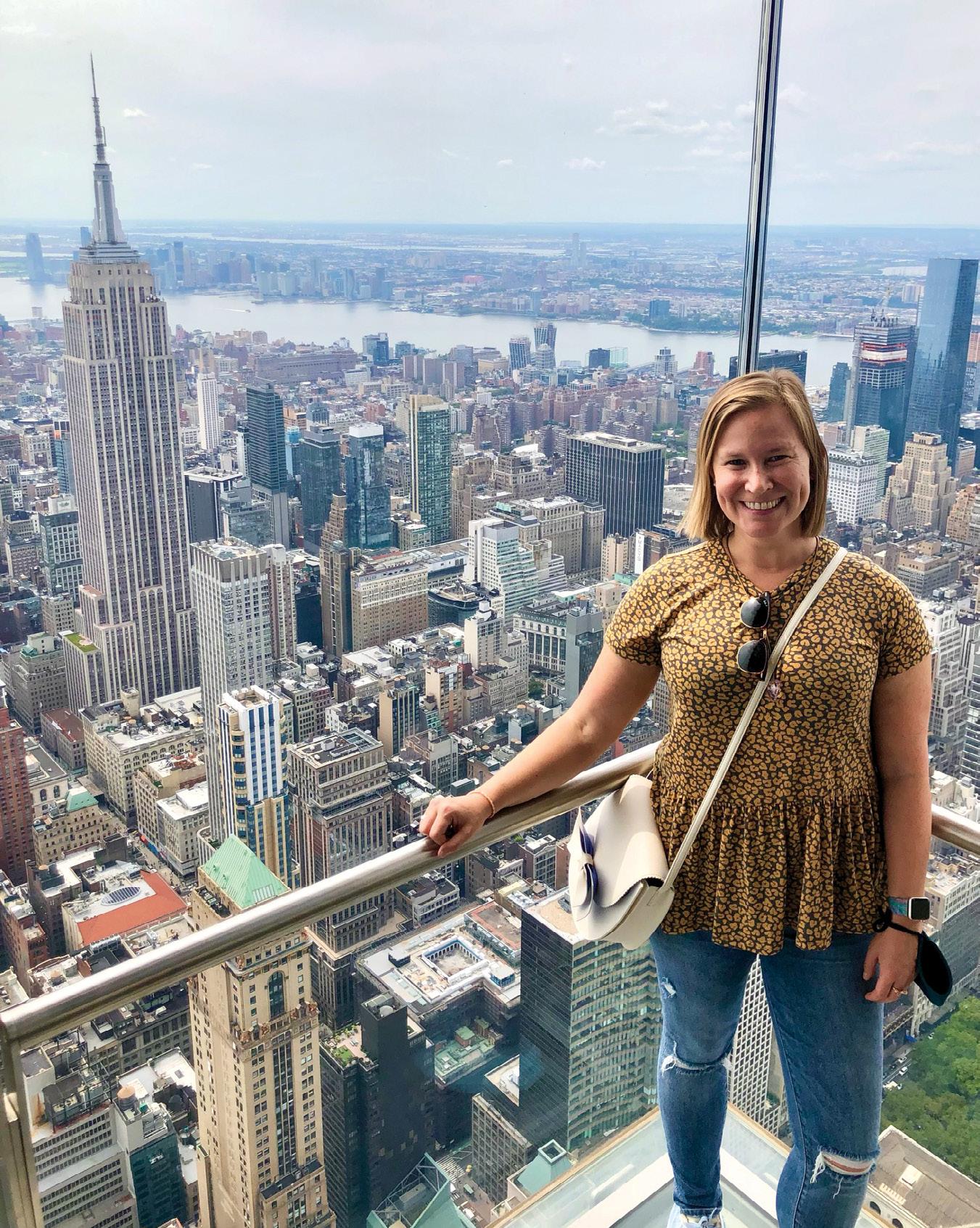
There’s a huge opportunity to make student travel more inclusive and accessible—to help more young people see the world beyond their hometowns.
